#Media News Nation Hindi
Explore tagged Tumblr posts
Text
Comprehensive Coverage of Bihar Politics News - 5th Pillar
In a state as politically vibrant as Bihar, staying informed requires a trusted source. 5th Pillar brings you comprehensive coverage of Bihar politics news, offering a balanced perspective on the latest developments. From the corridors of power to the voices of the people, we capture the pulse of Bihar’s political landscape. Our platform highlights major events, key decisions, and their implications for the state’s progress. With a commitment to transparency and accuracy, 5th Pillar ensures you have all the information you need about Bihar politics news.

#news in hindi#political#political news#politicians#politics#politics news#hindi news#election news#elections#bihar#hindi samachar#news article#news#world news#public news#celebrity news#breaking news#general news#technology#news media#news on gaza#news update#bihar latest news#latest news update#latest updates#bihar crime news#bihar samachar#bihar news#bihar politics#national news update
0 notes
Text
Jharkhand Vidhan Sabha News Hindi: Political Developments You Should Know
If you're keen on understanding the political developments in Jharkhand, 5th Pillar is the ideal platform for you. We offer daily updates and in-depth reports on Jharkhand Vidhan Sabha news Hindi, covering everything from budget debates to major political decisions. Our dedicated coverage of the Vidhan Sabha ensures that readers are well-informed about the state’s legislative processes, giving them a clear picture of how decisions are made and their potential impact. Whether it's the passage of crucial laws or updates on legislative reforms, 5th Pillar provides accurate and timely coverage in Hindi, making it easy for you to stay engaged with the latest political news from Jharkhand.
#jharkhand politics#politics#hindi news#bihar#bihar latest news#election news#bihar news#election 2024#bihar politics#bihar samachar#uttarakhand breaking news#uttarakhand news#uttarakhand ki news#news update#news article#news in hindi#news media#political news#general news#technology#national security#hindi samachar#latest news#latest news update#latest updates#election#presidential election#election day#election fraud#political
0 notes
Text
Discover the Latest News in Hindi with Padhega India
Stay ahead in the fast-paced world of information with Padhega India, your ultimate source for the latest news in Hindi. Our platform is dedicated to bringing you stories that matter, from local updates to global phenomena. Whether it’s politics, health, entertainment, or technology, we curate content that is both informative and engaging. With easy navigation and a focus on quality journalism, Padhega India ensures you can access the most relevant news whenever you need it. Explore our website to experience the power of news in your language.

#education#entertainment#exams#hindi news#hindi samachar#news#celebrity news#breaking news#celebrity#news article#uttarakhand news#news update#news in hindi#news media#political news#general news#technology#national security#latest updates#latest news update#latest cricket news#latest news on crypto#latest hollywood news#religion#eduaction#sports entertainment#sportsnews#sports#higher education#healthcare
0 notes
Text
Get In-Depth Religion News in Hindi Only at Padhega India
At Padhega India, we provide our readers with in-depth coverage of religion news in Hindi, offering unique insights into the religious practices and beliefs that shape India’s cultural identity. Our platform caters to those who seek a deeper understanding of religion and spirituality, whether it’s the latest news about Hindu temples, religious celebrations, or global religious movements. We bring you stories that matter, shedding light on religious issues, important dates, and the role of faith in people’s lives. With an emphasis on both traditional and modern perspectives, Padhega India offers a balanced view on all matters related to religion. Dive into our rich collection of articles and stay informed on the most important religion news in Hindi that influences millions of lives in India and beyond.

#education news#entertainment#government#hindi news#education#news#international news#breaking news#celebrity news#sports#maharashtra news#uttarakhand news#top news#news article#india news#world news#public news#national security#general news#technology#news update#news in hindi#news media#uttarakhand latest news#latest hollywood news#latest news update#latest updates#latest cricket news#entertainment news#sports entertainment
0 notes
Text
Real-Time Delhi Election News in Hindi at 5th Pillar
The Delhi elections are a defining moment for the city and its residents, and 5th Pillar is here to keep you updated every step of the way. Our dedicated Delhi election news Hindi section brings you the latest updates on polling schedules, voter turnout, and constituency-level analyses. We understand the importance of staying informed, which is why we provide breaking news and expert opinions in Hindi, making it accessible to a wider audience. With 5th Pillar, you can rely on timely and accurate updates that reflect the pulse of the elections, helping you stay informed and engaged.

#breaking news#celebrity news#election 2024#elections#delhi news#general election#bihar politics#bihar latest news#bihar news#hindi news#hindi samachar#news article#news update#news in hindi#news media#technology#national security#latest news on crypto#latest news update#latest news today#latest news in hindi#efcc#political news#crime news#2024 elections#election#election fraud#presidential election#election day#2024 election
0 notes
Text
Dive Into the World of Sports with Our Hindi News Updates
Sports is more than just competition; it’s a celebration of skill, passion, and teamwork. At Padhega India, we offer sports news Hindi that captures the thrill of the game for fans across India. Our news section covers all major sports events, including international matches and local leagues, giving fans timely updates and in-depth reports. Explore exclusive interviews, player spotlights, and match breakdowns, all in Hindi. For every cricket six, football goal, or kabaddi tackle, Padhega India provides engaging stories that keep fans connected to their favorite sports. Our coverage is designed to be both informative and enjoyable, bringing fans closer to the action and allowing them to experience the energy and excitement of each event. Stay with Padhega India for sports news that speaks your language and fuels your passion.

#government#hindi news#news from the world#news in hindi#entertainment#news update#religion#celebrity#celebrity news#bollywood#hindi samachar#breaking news#world news#news#news article#public news#national security#general news#technology#news media#sports entertainment#entertainment news#celebrities#job alert#sportsnews#sports#education#religion news
0 notes
Text
INTRO POST <3

Here's a long-overdue intro post.
NOTE - Do not dm me if we're not mutuals.
LINKS SIDE BLOGS: @i-think-im-breaking-down-again - more personal blog @cappuccino-circa-capillaries - mental health stuff /pos @a-bitch-can-write-poetry - poetry and web weaving reblogs, will post my original work if I ever get the courage @honestly-im-honest- silly stuff @edwinpayneshomosexualtendencies - dbda side blog
MEDIA: Pinterest Spotify Storygraph stats.fm
DA BASICS- ABOUT ME: Name - Lisa Avenir (you can call me Lise or Liz) Nationality - Indian Languages - English, Hindi, a1 French, aspiring German, a dialect of Hindi spoken in my home state which is completely incomprehensible to anyone who does not speak it to the point its an entirely new language (which it is but I'm not going to reveal it because I don't want my home state to be known) Age - minor Gender - Genderqueer Pronouns - they/them/she Sexuality - ace-spec lesbian Religion - Atheist DNI: Homophobic, Transphobic, sexist, racist, ableist, any kind of phobic in general No assholes allowed either I love receiving asks just no freaky stuff FACTS- 🪶Only Child who keeps losing friends 🪶I love any form of Noodles Soup 🪶I have a huge crush on Maya Hawke 🪶I love biology and anatomy 🪶I need psychological help /srs 🪶I cry a lot, it's an art 🪶I might have a migraine issue which might be getting better :D 🪶I have brown ass basic eyes 🪶Reading mythology is my bae 🪶My vocabulary might be good but I can't spell for shit. 🪶I love making little collages on PowerPoint 🪶I'm touch starved but touch aversed. Yes, we exist. 🪶I'm a nerd fighter 🪶I love dissecting song lyrics 🪶My aesthetic is dark academia, dark feminine(excluding the femcel bs), witchcore and sickly victorian child dying of the plague core 🪶I am a hyper-organized person who might have germophobia 🪶I'm pretty sure I have trichotillomania 🪶I have these sneeze attacks on a daily basis where I sneeze like 15 times over the course of 3 minutes
HOBBIES- 🪶Reading 🪶Writing poetry or songs 🪶Listening to Music 🪶Talking about stars 🪶The Universe 🪶Literature 🪶Science (fuck physics)
INTERESTS- MUSIC: I love listening to albums(like a LOT of them) 🪶Genre - Indie, Indie pop, Rock, Alt-Indie, Basic white girl pop, Pop-rock, Pop-punk, Folk, Old Bollywood, Male manipulator, Female Manipulator, Lesbian Manipulator, ghazal, anything that slaps 🪶Artists - Ricky Montgomery, Lana Del Rey, Chappel Roan, Flower Face, Taylor Swift, Hozier, Phoebe Bridgers, Girl in Red, Clario, Conan Gray, Hank Green, Hayley Williams, Joji, Indila, Sabrina Carpenter, Adele. Kishore Kumar, Lata Mangeshkar, Jagjit Singh, Muhammad Rafi, Asha Bhosle etc etc 🪶Bands - Wallows, Florence and the Machine, Sir Chloe, Hole, The Smiths, Paramore, Beach House, The Jayhawks, The Neighborhood, Fun Guns, Cage The Elephant, Arctic Monkeys, Chase Atlantic, Radiohead, My Chemical Romance, Hayley Kiyoko. 🪶Albums(favorites) - evermore and folklore by Taylor Swift, Montgomery Ricky by Ricky Montgomery, Depression Cherry by Beach House, Ceremonials and Lungs By Florence and The Machine, Superache by Conan Gray, Emails I can't send frwd: by Sabrina Carpenter, Hozier by Hozier, Riot! and Paramore by Paramore, AM by Arctic Monkeys, Party Flavors and I am the Dog by Sir Chloe, Punisher by Phoebe Bridgers, Rainy Day Music by The Jayhawks, Petals for Armour by Hayley Willams, The Rise and Fall of a Midwest Princess by Chappell Roan, Social Cues by Cage The Elephant, Live through this by Hole, Born to Die(The Paradise Edition) and Ultraviolence by Lana Del Rey, Nothing Happens by Wallows, Baby Teeth and Fever Dreams and The Shark in your Water by Flower Face, Lilt by Hikes, Get up and Move by Fun Guns, The Black Parade by MCR. 🪶Artists that I lowkey neglect but should high-key eat - Nirvana, Tame Impala, Men we trust, Cavetown, Pink Floyd, blink-182, Green Day, boygenius, Mitski, The Smashing Pumpkins, Suki Waterhouse. BOOKS- 🪶Genre - Dark, War pieces, Dystopias, Young Adult, Depressing, Dark Academia, Classics, Psychological Thriller. 🪶Ride or Die- The Book Thief, The Perks Of Being a Wallflower, The Picture of Dorian Grey, MAUS, Paper Towns, Looking for Alaska, All the Bright Places, The Midnight Library, The Handmaid's Tale, The Diary of a Young Girl, The Boy In The Stripped Pajamas, Circe, Before the coffee gets cold, Sharp Objects, The Martian, The DaVinci Code, The Emperor of All Maladies, Turtles all the way down, And Then There Were None, The Catcher in The Rye, No Longer Human, Grandpa's Great Escape, Wild Bird, The Giver. 🪶Honorable Mentions from my TBR - A Little Life, Bunny, If We Were Villains, The Secret History, 1984, To Kill A Mockingbird, Six Of Crows, Lord of the Flies, Piranesi, Cleopatra and Frankenstein, Crime and Punishment, How it Feels to Float, Orbiting Jupiter, Normal People, Fahrenheit 451, The Myth of Sisyphus, Lessons in Chemistry, Slaughterhouse-five, Dark Matter. 🪶Poets - Sylvia Plath, Emily Dickinson, William Wordsworth. Sappho,
MOVIES- Dead Poets Society, Good Will Hunting, Lady Bird, Whiplash, Spiderman: Into the Spider-Verse, Forrest Gump, Duck Duck Goose, Rapunzel SERIES- BBC Sherlock, Orange Is The New Black, Brooklyn99, Dead Boy Detectives, Heartstopper, Derry Girls, Modern Family, House md?
RANDOM IMAGES-








USERBOXES-










MOOTS APPRICIATION!!!! @lv3buzzz, @noctilucaa(my wife), @wilsons-three-legged-siamese, @yourfavvgal, @1mlostnow, @arrr-im-a-dead-poet, @perksofbeingpoet, @mighthavebeenmurder, @take-me-to-the-rooftop15, @poetsinnyc, @joonof1989, @deadcrowcalling, @pingunaa, @xxcherryberriezxx @burgundykicks (text me if you would like your name to be removed <3333 ) -🪶
#hello world#intro post#good evening sirs and ma'ams and enby overlords#a lise exclusive intro post just dropped#liz is short for liz bean#i can also be reffered to as gabe itch
37 notes
·
View notes
Text

A few stories about the Tangerine Tyrant caught my eye today, and they all point to his increasing desperation - so I figured I’d go around the horn and celebrate his continuing dissipation.
First: Criminal Defendant and Adjudicated Rapist Donald Trump yesterday predicted a “bloodbath” if he didn’t get reelected, and the media quickly devolved into outlets condemning his use of violent rhetoric and others - Fox and Newsmax - concern trolling over how he was talking specifically about the automobile industry. So, whatever. If you’re interested in parsing the event along those lines, have at it - but I think there’s a more interesting, deeply indicative phenomenon just below the surface that speaks not just to Trump’s mentality but that of his whole bonkers cult.
If you’re looking for the atavistic pull of Donald Trump on his followers, it’s in his power to do whatever the hell he wants and face no consequences. NO ONE can tell him what to do. NO ONE can keep him from attacking whomever he wants. NO ONE can prevent him from sating his desires. NO ONE.
Now, we know that’s not true - as evidenced by his exile to Mar-a-Lago for the past three years, but it’s part of the mystique. In a lot of ways, it makes sense if you look at his cult following - people who are, by and large, deeply disempowered and enraged at a culture that is stripping away their traditional privileges and social entitlements. They WANT Trump to keep shitting the punch bowl as a sort of wish fulfillment of their own stifled rage. Maybe they can’t rape the woman they want to rape or kill the immigrants they hate for speaking Spanish or Hindi at the Gas-n-Sip – but they sure as hell can dream about it when Trump gives a cross-burner of a speech. That’s all standard form.
But what we saw last night - and in the fascist outrage-trolling today - was something new. It’s been creeping into the 2024 election cycle here and there, but yesterday, it entirely broke through, and it’s this: NOT EVEN TRUMP’S BRAIN IS ALLOWED TO CENSOR TRUMP’S MOUTH WHEN IT COMES TO RAGE AND ANGER.
Look, Trump KNOWS that using words like “bloodbath” is going to cost him non-MAGA voters. He knows that calling people “vermin” is going to hurt his chances of navigating the very narrow path ahead if he hopes to return to the White House. Yet, he can’t stop himself. Trump is unable to act in his own easily achieved best interest if it means not being a monster, and while it’s lamentable that he’s bringing such hatred to our national debate, I encourage him to keep it up.
You be you, Donald!
Every single time you let your id out of its box, it’s like sending America an unsolicited, mushroom-shaped dick-pic. Sure, your fans are going to love it, but the rest of us grossed the fuck out.
So, please! Rage on!
-----
Second:
Trump’s lawyers in the NYS civil fraud case settlement submitted a filing today that it is “a practical impossibility” for Trump to post a bond for the half-billion dollars he needs to cough up in order to appeal the decision. According to reports, he approached 30 different surety companies, and they all turned him down. Why they would do that might indicate what’s got him tuned to “bloodbath” and “vermin” levels of rage.
It might be a simple point, but it bears a paragraph of explanation.
Most folks who don’t work in the NYC real estate market – or any real estate market – might think, “Hey, he’s a rich guy. Why not just sell a few of those buildings he owns? They’ve gotta be worth a pretty penny.”
Or, alternatively, “Why won’t anyone take Trump Tower as collateral for a loan?”
The simple answer is he doesn’t really OWN any of that shit outright. It’s ALL mortgaged to the hilt. To get a clearer picture of this, let’s look at 40 Wall Street – one of Trump’s “prestige” properties.
The numbers are a bit hard to come by, but an hour of reading suggests that the building is presently worth about $200 million. Mind you, part of the fraud charges – now proven – included his valuation of the building in 2015 at over $750 million, but it’s just not worth that at all.
So, take the $200 million as a starting point and note that Trump’s mortgage on the property, according to a Bloomberg report in November of 2023, stands at $122 million. So, if Trump were to liquidate his stake in the property fully, he’d only net about $78 million – and that is BEFORE the capital gains taxes, NYS taxes, and NYC taxes on the sale. According to a few articles I’ve scanned this evening, that would be up to about 40% of his earnings. That means, even if he drops one of his most precious assets, he would only raise about $50 million.
He owes TEN TIMES that number by next week.
Play that out another round, and realize that if Trump tried to sell ten or twenty office buildings in NYC all at once, the price of ALL of them would plummet to fire-sale prices.
He’s fucked. Moreover, he knows it and is desperate to find a way out.
-----
This brings us to news item number three: The Return of Paul Manafort.
News leaked today that Trump is considering bringing convicted felon and former campaign manager Paul Manafort back into his 2024 bid for the White House. Manafort, primarily due to his complete lack of a moral center, would be a tremendous asset for Trump. He’s a solid political operative, but what he REALLY brings to the table is a direct line back to the Russian oligarchy and their money. That, obviously, is an enormous threat to national security, and I’ve got to hope that the intelligence services in DC and around the world will be on heightened alert for any covert – or overt – entreaties to Putin or his cronies for a loan. I’ve got to hope there are ways of making such entreaties known to the public through selective leaks if nothing else.
But that brings us back to observation number one.
Trump knows that going to Putin for help with his financial difficulties if it becomes known, would be a dagger to the heart for his chances of returning to the White House. Yet, if I’m right, he will be unable to stop himself when it comes to finding a fix for his hemorrhaging empire. His brain will tell him this is a terrible idea, but it won’t matter. NO ONE is allowed to stop Donald Trump from doing whatever the hell he wants to do – not even Donald Trump.
In 1776, James Otis, a thoughtful supporter of the Revolutionary War, noted about politics, “When the pot boils, the scum will rise.”
Trump is proving that to be true, even when there’s only one evil, arrogant, rapist bastard in the soup. He’s so screwed.
Love to you all.
Michael J. Tallon
14 notes
·
View notes
Text
By: Jon Haidt and Zach Rausch
Published: May 15, 2023
When parents are asked to identify their top fears about the safety of their children, what do you think tops the list? According to a survey last year by Safehome.org, it’s not cars, strangers, or any other physical threat; it’s “internet/social media.” That’s not just for parents of teenagers and pre-teens, whose lives seem to revolve around their phones. It’s even true for parents of younger kids, ages 7-9 because every parent sees it coming and few know what to do about it. Parents don’t want their children to disappear into phones, as so many of their friends' children have; some resolve to wait until 8th grade, or later. Then their child hits them with the main argument that makes parents buckle: “But everyone else has a phone, so I’m being left out.”
For parents who resisted, or who plan to resist, a new report may encourage many more parents to join you: Sapien Labs, which runs an ongoing global survey of mental health with nearly a million participants so far, released a “Rapid Report” today on a question they added in January asking young adults (those between ages 18 and 24): “At what age did you get your own smartphone or tablet (e.g. iPad) with Internet access that you could carry with you?” When they plot the age of first smartphone on the X axis against their extensive set of questions about mental health on the Y axis, they find a consistent pattern: the younger the age of getting the first smartphone, the worse the mental health that the young adult reports today. This is true in all the regions studied (the survey is offered in English, Spanish, French, German, Portuguese, Arabic, Hindi, and Swahili), and the relationships are consistently stronger for women.
We believe these findings have important implications for parents, heads of K-12 schools, and legislators currently considering bills to raise minimum ages or require age verification for some kinds of sites (especially social media and pornography). We’ll address those implications at the end of this post. But first: what did Sapien Labs do, and what did they find?
1. The Sapien Labs Study
Sapien Labs is a non-profit research foundation with the goal of understanding how the rapidly changing social and technological environment is changing human brains and minds. Their main research project has been the Global Mind Project, an ongoing program that tracks mental well-being around the world using a comprehensive assessment of mental health along with questions about demographics and various cultural, technological, and lifestyle factors. They have issued a variety of reports on the state of mental health around the world. Among their most important findings is that in all the regions they’ve studied, mental health is worst for the youngest generations.
It didn’t used to be this way. There is a well-known finding in happiness research that, across nearly all nations, happiness or well-being forms a U-shaped curve across the lifespan (See Rauch, 2018). Young adults and people in their 60s and 70s are happier than those in middle age. But that may be changing, especially for women, as Gen Z (born in and after 1996) enters young adulthood. You can see the sudden collapse of young adult mental health in some of our previous posts on this Substack. For example, Figure 1 shows that up until 2011, young Canadian women were the most likely to report having excellent or very good mental health. By 2015 they were the least likely, and the decline in their self-reported mental health accelerated after that, while it changed very little for older women. (The same pattern holds for Canadian men, but to a lesser degree.)

[ Figure 1. Percent of Canadian women reporting excellent or very good mental health, by age group. Canadian Community Health Survey (2003-2019). Graphed by Zach Rausch. ]
Why would this be? What changed in the early 2010s that could have rapidly reduced the mental health of teens around the world, with a bigger impact on girls? At the After Babel Substack, we have argued that the sudden switch of teen social life from flip phones (which are designed for communication) to smartphones (which enabled continuous access to social media and much higher levels of phone addiction), is the major cause, though not the only one. There are unique factors at work in each country, but we know of no alternative that can explain the synchronized, gendered, and global decline in teen mental health.
At Sapien Labs, they decided to test the smartphone hypothesis by adding a question about the age at which people got their first smartphone (or tablet). Is it just a coincidence that the first global generation to grow up on smartphones became the first global generation to have lower well-being than the one before them?
Sapien Labs uses a comprehensive assessment of mental well-being that asks participants about 47 elements of mental, social, and emotional functioning on a life impact scale. These 47 elements are aggregated into a single score called the Mental Health Quotient (MHQ), which gives extra weight to patterns that indicate severe problems. It also uses subsets of these 47 elements to create scores along six domains: Mood & Outlook, Social Self, Adaptability & Resilience, Drive & Motivation, Cognition, and Mind-Body Connection.
(You can take the MHQ yourself and you can request access to the full dataset. For scoring and validation of the MHQ, see Newson, Pastukh, & Thiagarajan, 2022, and see this blog post that offers a clear explanation of how the MHQ is scored, and why.)
Figure 2 shows the most basic result in the report: they simply plotted the responses from the nearly 28,000 participants who answered the “first phone” question, from all countries combined.
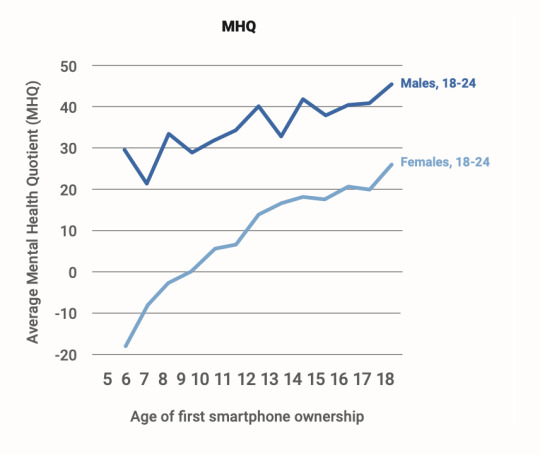
[ Figure 2. As age of first smartphone goes up, so does the mental health reported by young adults, assessed by the MHQ. Data from SapienLabs.org. ]
MHQ scores are calculated from responses to the 47 questions and converted to a scale that runs from -100 to 200, as shown here:

As you can see, the respondents who got their first smartphone before they were 10 years old are doing worse, on average, than those who didn’t get one until they were in their teens. The most mentally healthy respondents are those who did not get a phone until their late teens.1 You can also see that the slope is steeper for young women than for young men. The Gen Z women who got their first smartphone before they were 9 years old are in negative territory, on average.
The power and unique contribution of the Sapien Labs dataset come from two features of their work: First, they use a far more detailed measure of mental health than is used in most other large surveys. The second important feature is their international coverage. So, let’s zoom in and explore the six domain scores that make up the MHQ, first for the global sample, and then for the region and culture we know best: the Anglosphere.
2. Domains of Functioning
As you’ll see if you read the full report, the next step after examining the overall MHQ scores is to examine scores on the six domains of mental functioning:
Mood & Outlook: Includes items about optimism, calmness, anxiety, mood swings, sadness, and anger.
Social Self: Includes items about self-worth, relationships with others, empathy, cooperation, aggression toward others
Adaptability & Resilience: includes items about adaptability to change, ability to learn, and emotional resilience.
Drive & Motivation: Includes items about motivation, curiosity, enthusiasm, and addictions.
Cognition: Includes items about memory, decision-making and risk-taking, focus, and concentration, unwanted thoughts, hallucinations
Mind-Body Connection: Includes items about sleep quality, energy level, appetite, and physical health issues.
Figure 3 shows that for young women, all six domain scores show the same basic pattern as the MHQ: a consistent rise. You can also see that a few of the domains seem to rise more slowly or level off somewhat after the age of 13 or 14: Drive and motivation, Mind-body connection, and Cognition. However, the other three dimensions continue to rise all the way to age 18. The domain that rises fastest, meaning that it is most highly correlated with age of first smartphone, is the “social self” domain.
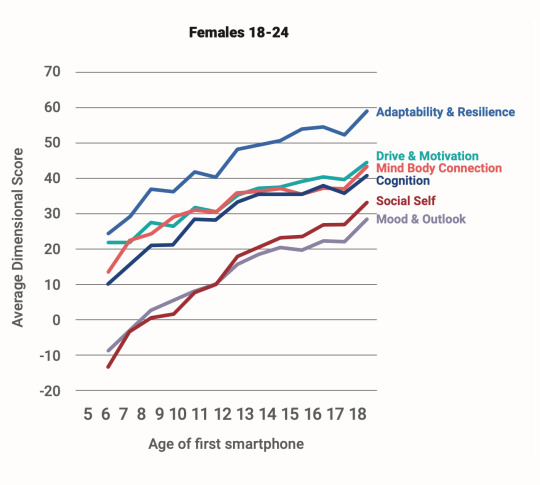
[ Figure 3: The 6 domains of well-being, for young women, as a function of when they got their first smartphone. From SapienLabs.org. ]
Figure 4 shows the same analysis for young men. The pattern is similar, with two important exceptions. First, the slopes are substantially lower, meaning that the mental health and well-being of young men are not as strongly related to the age at which they got their first smartphone as it is for their sisters, although it is still related. (All of the significance tests and effect sizes can be found in supplementary materials posted in this Google Drive link.2) The second difference is that all of the lines are higher for boys, meaning that boys are doing better than girls at all ages (at least, according to their self-reports). The one exception is that the line for Adaptability & Resilience reaches the same level for both sexes by age 18. Given the steeper slopes of all six lines for girls, this means that sex differences in adult mental health are larger among those who got a smartphone earlier.
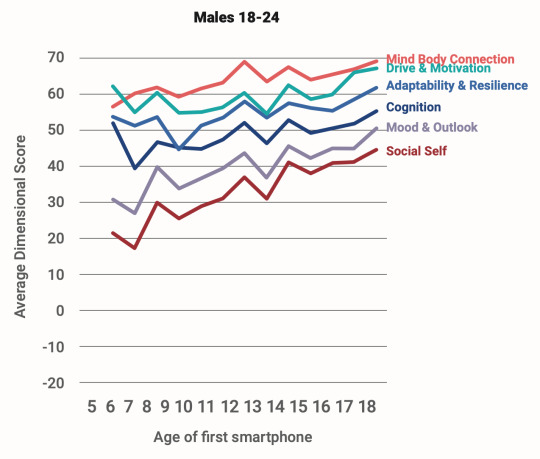
[ Figure 4: The 6 domains of well-being, for young men, as a function of when they got their first smartphone. From SapienLabs.org. ]
One major issue in analyzing an international dataset is that there are just so many differences between countries, regions, and religions that there are many opportunities for confounding variables to lead us astray. For example, in the Sapien Labs dataset, in the less wealthy countries such as India, few young adults had received a smartphone before the age of 10, which means that the data points on the left sides of the graphs contain almost no Indians, whereas the data points on the right side (no phone until 17 or 18) contain many Indians and fewer from the USA. If Indians are mentally healthier than Americans (for other reasons), this could cause the lines to slope even if smartphones had no effect on mental health. It is important, therefore, to look at individual countries and regions. (The Sapien Labs report does this in its appendix, where you can see that the trends hold for each of the world regions).
The region that we (Jon and Zach) know best and have written on extensively is the Anglosphere (the English-speaking countries of The United States, Canada, The United Kingdom, Australia, New Zealand, and sometimes Ireland). We, therefore, decided to examine what Sapien Labs had found about those countries and compare it to what we have found.
3. Zooming in on the Anglosphere
At the After Babel Substack, we have been documenting the patterns of rising mental illness among teens around the world, and, like Sapien Labs, we have found that the sudden decline of teenage mental health is an international phenomenon. Our research so far indicates that the increases in mental illness in the 2010s were slightly larger in the Anglosphere than in any other region we’ve examined. Figure 4 shows the large and sudden rise in self-harm rates among teens, particularly girls, in four of these nations (you can see much more in Zach’s initial report on the Anglosphere).
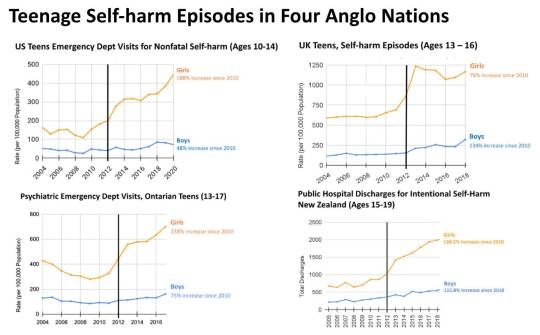
[ Figure 5. Since 2010, rates of self-harm episodes have increased for teens in the Anglosphere countries. For data on Australia and for all sources, see Rausch and Haidt (2023). ]
In every Anglosphere country, the mental health of teens declined sharply around the same time (~2012) and in the same way (depression, anxiety, and self-harm, with bigger increases for girls). We have also found that the five Nordic nations show similar trends, particularly when examining changing rates of depression and anxiety (though not always for self harm).
The Sapien Labs study began in 2019 so it cannot show us trends since 2010, but it can show us how young adults are doing today, and it can link variations in mental health today to variations in age of first smartphone. We wanted to get more familiar with the data and examine these links for ourselves, so we downloaded the full dataset as it was available on their Brainbase site on May 13, 2023, which was just about 2 weeks later than the dataset used in the Sapien Lab report. Our dataset contains 1,798 more participants, for a total of 29,767. The number of participants from the six anglosphere countries was much smaller: 1,465 (823 females, 584 males). By country: 682 in the USA, 297 in the UK, 224 in Canada, 239 in Australia, 10 in New Zealand, and 13 in Ireland.
We cleaned and organized our dataset in the same way as the team at Sapien Labs, with a small modification to account for our much smaller sample size. To reduce the jerkiness of the graph lines when we drop down to lower numbers of respondents for each point, we grouped participants into 2-year buckets (or three years, for our youngest bucket, 5-83). Figure 5 shows that the MHQ scores of Anglosphere boys and girls show patterns very similar to those reported in Figure 1 by Sapien Labs for the full 28,000-person international sample: The later the age of smartphone acquisition, the better the mental health. At least, that is true for the girls, all the way up to 18. For Anglosphere boys, there is a leveling off after the 11-12 mark. Delays beyond age 12 do not seem to be related to further increases in MHQ scores.4
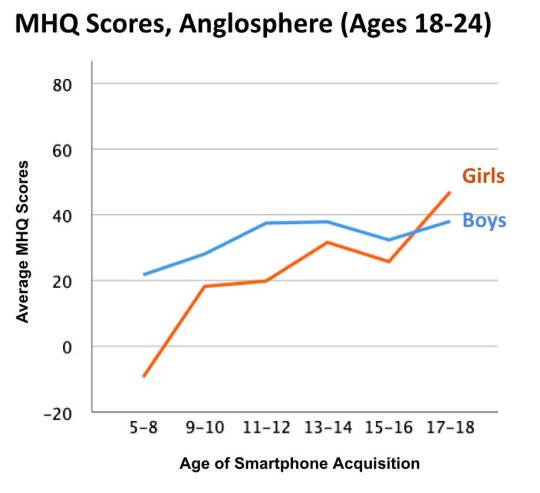
[ Figure 6. Anglosphere countries only: As age of first smartphone goes up, so does the mental health reported by young adults, especially for women. Data from SapienLabs.org, graphed by Zach Rausch. ]
We also plotted the six MHQ domain scores and found similar results. For females, all six dimensions of mental well-being improve as the age of smartphone acquisition increases.5 The effects are particularly strong for the “social self” and “mood and outlook”, which correspond well to the rise of internalizing disorders (depression and anxiety), which Zach has shown is rising within every Anglosphere nation.

[ Figure 7. Anglosphere countries only: female MHQ dimension scores. Well-being on all 6 dimensions increases as age of smartphone acquisition increases. ]
The trends for boys are similar to girls, though the effects are smaller and there is more fluctuation.6 Figure 8 shows that at the youngest ages, increasing age corresponds with improvements in each of the six dimensions. However, for boys, improvements tend to level off after age 12.
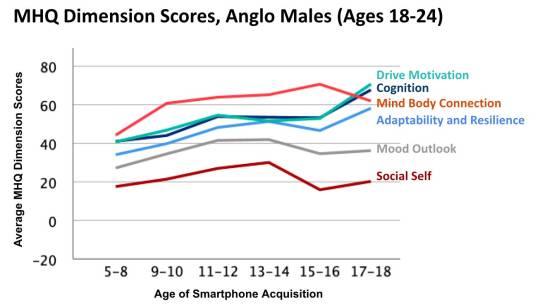
[ Figure 8. Anglosphere countries only: male MHQ dimension scores. Changes are smaller and more varied compared to females. ]
4. Limitations
It’s important to note that the report from Sapien Labs is one of their “rapid reports” made possible by their fast-growing number of participants and the easy access they offer to their data. They added the question about age of first smartphone in January and they are publishing a report, with data from nearly 28,000 participants, in May. We believe that this ability to move quickly is a public service during a global pandemic of teen mental illness. While their rapid report is not a standard academic publication and has not been through peer review (which often takes a year or more), the open access to the data has allowed us to investigate and confirm the trends they are reporting. We hope and expect that other researchers will download the dataset and offer critiques of the data, the analyses, and the conclusions drawn. This sort of “post-publication peer review” is becoming increasingly common as the problems with the existing peer review system become more widely known.
One issue to keep in mind with the Sapien Labs dataset is that the participants in each country are not a random or representative sample of the people in that country. Such studies would be extremely expensive to run, and now that so few people agree to phone solicitations or even answer their phones, it is unclear how representative such surveys can be. Those who agree to be interviewed, or who are motivated by money to participate, are not representative of the broader population. For this Sapien Labs report, participants came to the site on their own, or from online advertisements paid for by Sapien Labs, for the purpose of getting a detailed report on their wellbeing. So, the means reported for any country should not be treated like direct measures of the true means. However, samples such as these are still very useful for examining differences within the sample, such as those between men and women, or between those who got a smartphone early and those who got one late. And the much larger size of the Sapien Labs dataset, compared to Gallup and other survey organizations, allows for many additional analyses.
A second factor to keep in mind is that like all surveys, what we get is correlational data that is open to alternative interpretations. The graphs in the report are likely to suggest to most readers that getting a smartphone early causes later mental health problems. But with correlational data we must always consider the possibility that the causal arrow could run in reverse. In this case: having low well-being as a young adult could cause people to believe that they got a smartphone earlier than they did, but this seems unlikely. We must also always consider that there could be “third variables” that cause both of the first two variables to rise. In this case, one plausible confounding third variable is permissive parenting. Perhaps permissive parents (in each country) simultaneously do two things: they give their kids smartphones at very young ages, and they also give them few boundaries and little structure, which then interferes with development and produces struggling young adults. While this hypothesis is plausible and should be investigated, it is not clear how it would explain the fact that, in all the regions studied, it is the girls who show a tighter connection between early phone acquisition and later mental health problems, just as it is the girls who show a tighter connection between heavy social media use and concurrent mental health problems. Nor would it explain why mental health dropped so rapidly in the early 2010s (especially for girls) if permissive parenting (or some other variable about family life) was the real culprit.
And finally, we note that no one study is definitive, and more research is needed. We have been able to find a few other studies that examined the age at which children got their first smartphones (We have created a new appendix [8.14] in our collaborative review doc on Social Media and Mental Health). So far they are mostly smaller studies that have produced mixed results. If you know of any others, please add them to the doc or put a link to them in the comments below. We want to get this right.
5. Implications
We cannot be certain that the correlations shown in the data are evidence of causality, but we think it is appropriate for those who care for children to act on the preponderance of the evidence (which is the standard in a civil trial) rather than waiting for evidence beyond a reasonable doubt (which is the standard used in a criminal trial. See proposition 2 in this post.) There is increasing evidence that smartphones have a variety of detrimental effects on child development including reductions of sleep, focus, and time with friends in person, along with increases in addictive behaviors, so it makes sense that the cumulative effect of getting one’s first phone in elementary school would be larger than for those who don’t get a phone until high school. This is an important point made in the Sapien Labs report: The relationships they find suggest that there is a cumulative effect of having had a smartphone (and its many apps) over many years of childhood; they do not represent the effects of having used a phone a lot in recent days or weeks (which is the focus of most of the published research).
We think the implications for action are strongest for policies related to children and younger teens––those still in elementary and middle school (that is, age 14 and below) In most of the graphs in this post, including those for the Anglosphere, the slopes of the lines are steepest for those ages, and the links are visible for boys as well as girls (though smaller for boys). This concern to protect children before and during early puberty is consistent with a study published last year which found that in a large longitudinal study of British adolescents, the peak years for evidence of links between social media use and lower satisfaction with life were 11-13 for girls (which corresponds to the early part of puberty), while for boys (who begin puberty a bit later) it was 14-15.
On the other hand, the implications for action related to older teens and especially boys are less clear, at least within the United States and other Anglosphere nations. The lines for boys are somewhat flat in those ages, and the increases for girls generally slow down too. Furthermore, the arguments for why high school students need a smartphone (rather than an alternative, such as a flip-phone) are stronger than the arguments for why elementary and middle school students need one.
We, therefore, believe that the Sapien Labs findings should motivate us to think carefully about whether and when to give children their own smart devices, especially before high school. It is not the Internet per se that is harmful; so much of the internet is fantastically educational, useful, and entertaining. The most relevant questions, we think, are: 1) At what age do you want to give a child continuous access to the internet and social media, even when away from home, even when sitting in class? 2) At what age do you want to give social media companies, and other companies, continuous access to a child’s attention? And 3) does a child really need a smartphone when other kinds of phones (such as “flip phones” or Light Phones) work just as well for general communication (phone calls and texting)?
Implications for Parents
The group Wait Until 8th was founded to solve the collective action problem that parents and teens are in: Even if most parents wanted to wait until high school to give their children smartphones and social media, as long as most kids have those things by 6th grade, there will be enormous pressure on their children, and hence on the parents, to relent. Unless the parents can coordinate. So Wait Until 8th asks parents to sign a pledge, when their children are in elementary school, that they will wait until 8th grade to give them a smartphone. The pledge only takes effect once ten families in that child’s grade have signed the pledge so that the child will have a community of peers and will not feel so isolated before 8th grade.
We think this is a great idea, we just suggest that the pledge should be: Wait Until 9th. Or Wait Until High School. Children are usually 12 or 13 at the start of 8th grade; that is still within the period of early puberty. Plus, if 8th graders have smartphones, that means that smartphones will be everywhere in middle schools, increasing the desire of 7th graders to get them. To solve collective action problems, we think it’s best to focus on setting good norms within collectives (such as schools): make elementary schools and middle schools be smartphone free.
Parents understandably want to be able to reach their children when they are away from home, and a flip phone or other “dumbphone” is a very reasonable first phone that allows parents and children to reach each other. We suggest that parents not give smartphones as first phones. Let children learn to master a simpler kind of phone, one that cannot be loaded with addictive apps. Wait Until 8th offers an excellent list of the many smartphone alternatives.
Implications for Schools
Many of the teachers and heads of schools that Jon talks to are bitter about the effects of smartphones on their students and their school culture. They complain about the constant drama unfolding on social media during the school day. They complain about the distraction and the increased difficulty of getting students’ attention during class, since many students sneak looks at their frequently-buzzing phones, especially those sitting in the back rows. Many schools say that they ban phones, but what they often seem to mean is “the rule is that you can’t take out your phone during class.” That means that some students (the ones most suffering from phone addiction) will learn to do it stealthily, and many of the rest will just pull out their phones as soon as class is over, thereby missing out on face-to-face interactions with the students right next to them.
We suggest that schools consider going phone free, meaning that students can use their phones to arrive and depart from school, but once they enter, their phones (smart or dumb) would be placed in a phone locker, or in a lockable pouch. We think the case for doing this in elementary schools and middle schools is strongest. In a few weeks, Jon will write a substack post laying out the empirical evidence that smartphones distract students and disrupt education, even when they are kept in students’ pockets.
We also suggest that school districts collaborate with social scientists to do experiments on entire schools, rather than on individual students. What if a state or district identified 20 middle schools that were willing to cooperate, and then randomly assigned half of them to go phone free? There is no research of this kind that we can find, yet such a simple study would give us results within a single year that could potentially yield findings that improve both mental health and educational outcomes.
Implications for Legislatures
If there is a cumulative effect of smartphone ownership in childhood, and if the effect is due in part to heavy use of certain kinds of apps (such as social media) rather than other kinds of apps (such as watching movies, or using Wikipedia), then it becomes even more vital that we develop ways of age-gating certain apps and content. At present, US law sets a minimum age of 13 at which children can sign contracts with companies to give away their data (when they check a box on the terms of service). But the law was written such that the companies are not required to verify ages. As long as a child says that she is 13 or older, she’s in and can create a social media account.
This must change. If the minimum age were enforced, it would help parents solve their collective action problem, at least with regard to Instagram, Tiktok, and other social media sites for underage users. It is precisely Congress’s failure to enforce the age 13 rule that puts parents in the trap. Many states are now introducing legislation to remedy this omission. And there is one federal bill that does a particularly good job of focusing on age limits and age verification: The Protecting Kids on Social Media Act, introduced by Senators Schatz (D-HI), Cotton (R-AR), Murphy (D-CT), and Britt (R-AL). The act would “set a minimum age of 13 to use social media apps and would require parental consent for 13 through 17 year-olds. The bill would also prevent social media companies from feeding content using algorithms to users under the age of 18.” The bill also requires social media companies to develop rigorous age verification methods. (There are already many in existence, and many more would appear if the bill gets passed.) We also think the Kids Online Safety Act of 2022, introduced by senators Blumenthal (D-CT) and Blackburn (R-TN) would do a lot to make social media less damaging to children, and easier for parents to control. The fact that so many bills are bipartisan, at both the state and federal level, is a very encouraging sign in our polarized time. Legislators often report seeing the problems in their own children.
In conclusion: there is a great deal that can be done, individually and collectively, to address one of the top fears that parents express, about the safety and health of their children. The Sapien Labs data offers us new insight into the nature of the problem, and it alerts us that the problem may be global. It also guides us to the ages at which reform efforts are most likely to work.
--
POSTSCRIPTS (added on May 18, 2023)
1—We welcome additional and deeper analyses of the Sapien Labs data, and will post links here to such reports whether they support or contradict our analyses in this post.
2—One issue we should have discussed in the text is the inclusion of tablets, along with smartphones, in the Sapien Labs’ questionnaire. If their findings differ from those of other labs which asked only about age of first smartphone, then we won’t know whether part of the difference is the inclusion of tablets. We hope that future studies will ask about the two devices separately to figure out which devices are associated with harm at which ages (if any).
3—Some commentary online has made the important point that it’s not the phone itself which is harmful; it is the particular apps that the child uses, a child with a particular personality, in the context of a particular family that does (or does not) exercise oversight and apply restrictions. We agree. The original iPhone introduced by Steve Jobs was three devices: a phone, an iPod, and a web browser. Great! Three tools. Probably not harmful. It’s the addition of the app store that turned the smartphone into a portal to everything. If early acquisition of a smartphone is shown to be reliably associated with developmental problems, it would likely be because it enables continuous 18-hour-per-day access to hundreds of activities.
#Jonathan Haidt#Zach Rausch#smartphone#smartphone use#mental health#mental health issues#mental illness#depression#Sapien Labs#smart phone#smart devices#Mental Health Quotient#human psychology#psychology#religion is a mental illness
9 notes
·
View notes
Text



In September 1931, Charlie Chaplin, during his second tour of Europe promoting his new film "City Light's", met Mahatma Gandhi in London. It was a meeting of two giants from completely different fields of work. One of them was a legend of politics, a nationalist, a lawyer and a father of the nation, and the other was the most important idol of cinema, the greatest entertainer and a legend of cinema. Unlike Charlie Chaplin, Mahatma Gandhi was not a fan of films and watched only two films in his life, one in English and one in Hindi.
Mahatma Gandhi did not know Charlie Chaplin's work, he did not know who he was.
The meeting was widely commented on in the media, with a lot of journalists and photographers.
Mahatma Gandhi opposed the abuse of machines. Charlie Chaplin asked him about his views on the "abhorrence of machines", to which Mahatma Gandhi replied:
"Machines have in the past made us dependent on England, and the only way in which we can free ourselves from this dependence is by boycotting all products manufactured by machines."
On hearing Gandhi speak about machines, Charlie Chaplin wrote in his notebook:
"I received a clear lesson in tactical maneuvering in India's freedom struggle, paradoxically impressed by a practical, manly visionary with an iron will to endure it."
He also attended a prayer with Mahatma Gandhi.
Charlie Chaplin was greatly impressed by Mahatma Gandhi, who inspired next film, "Modern Times". It was one of Charlie Chaplin's best films!
4 notes
·
View notes
Note
for the ask game, 20 and 7? And also, u don't have to answer but I'm curious how u would change India's characterization/how u would improve on it :0
Hey babe, Hetalia ask game dropped!
Thank you for the ask! Sorry for this being so so late sahdk
20) Answered here
7) Food-related headcanon? (im hungry)
India: I definitely think he'd be a sucker for spicy food. But I also think he'd absolutely love extremely sweet food. This is based on personal experiences, but Indian food has a extremely sweet to extremely spicy side lol. For example, some foods that are on the wayyy too sweet side for me personally are Barfi, Jaleebi and Kesari (I do enjoy them tho lol). So, I think that India definitely cares a lot about the favor and experience the food gives a person :)
As for India's characterization! Ok, I've been thinking about this since the day you sent me this ask lol and I really hope you don't mind but the first bit is a bit rant-ish to clear up some misconceptions.
So first thing I really want for people to understand India is that, it is not just the North. There is no 'dominant' culture, and Hindi is spoken as more of a connecting language more than like- a first language by a lot of people that live in places other than what I like to call the "Hindi Belt"
1)The Idea of Northern Culture as a 'dominating' culture does not make sense and kinda erases the other cultures that live and very much thrive in India today. If you went and only toured around North India, you would see a huge difference between cultures up there alone! I understand that this idea that Northern Culture dominates India is from the wide spread knowledge of Bollywood. But India's really diverse! We even have a lot of film industries for each language! Tollywood, Kollywood, Mollywood, Sandalwood, etc. But, I'm getting off topic, Northern Culture does not 'dominate' the majority of Indian Culture, and Northern Culture itself is very hard to define because it's diverse! From Rajistan to Punjab, the cultural differences are very different in the north, so imagine the differences from north India to the south- not even accounting for the tribal cultures in each state!
2) Most Indian languages stem off of two language families: Indo-Aryan and Dravidian and if you look on a map of language families, you can almost see a clear line between these languages. Within those branches, stems of languages, a lot of them are still spoken today. So making Hindi the only language India speaks doesn't make that much sense to me and erases literally every other culture living and very much thriving today!
How I'd Improve it in the Anime
For an Anime that's portraying nations based on stereotypes, I would say- it could be worse lol. I do get why Hima portrayed India like that, I mean it's not as bad as some other media I've seen that portrays India as: "Taj Mahal, Snake charmers, Tiger, Elephant, Elephant, Middle Eastern Culture for some reason". So for a anime about stereotypes it's not that bad lol. There's maybe like two things I'd change?:
-Make India a little more easy to anger than easy going. I guess hetalia is about stereotypes and the stereotype is that Indians are very "Yoga, Buddhism/Hinduism, Rangoli" not about actual cultural stuff of characters, but yeah I'd probably make him a little bit more of a hot head lol
-Make him appear more in the anime/manga!! He only shows up like three times and usually in background roles, micro-nations show up more than him T-T
My Own Characterization
Some positives:
Kindness: I feel like India is very generous and nice to everyone he meets. When he meets a new country or person he usually tries to be as nice and respectful as he can with them before forming an opinion about them. I'm just basing this off of age. I feel like at a certain point (as with most ancient nations), he realized that country's relationships with each other are very unexpected and so he tries to start off on a good note.
Emotionally Resilient: This might be a given because he is a nation lol, they've lived a long time and can adapt to unexpected situations really easily. I also feel like because he's an ancient, he still feels those knee-jerk emotions/reactions but it takes more to trigger them if that makes sense.
Makes Connections Easily: A large part of Indian culture, is family and community. Families, back then often lived in one house. Often with an opening in the middle where the family hangs out or lived in a community of houses close to each other. So I definitely feel like he gets close to people very easily and often treats them as family.
Flaws:
I feel like in his early years India would have been easy-to-anger and have some amount of arrogance? It's just two traits that I've seen amplified, if not glorified, by Indian movies because they're seen as very masculine traits to have (in general).
Easy-to-Anger: Because of how long India's lived, I feel like he has a lot more patience now days but certain topics or someone being insistent might make him quick to anger.
Arrogance: I feel like arrogance is something all nations have, it's a given, but again, time and experience wears it down. So, I feel like compared to other nations, he's more down to earth, but still pretty arrogant.
Stubborn: He is stubborn, he protests heavily for the the things he believes in and does not stop until he gets his way. He can remember something that someone said centuries ago and continue to do something just to spite them.
General Headcannons:
He loves Dance, Music and the Arts: In India, Classical Dances are very important. It was used for entertainment, religious purposes and also used for storytelling! There are some that are similar to theater, there are dancers telling the story of a mythological event, dances that are related to gods, or dances that were simply made to entertain royals.
And regional music where do I start! Indian music is diverse, and there are a lot that I could mention from my state alone! There are different rhythms, elements, instruments, different focuses, and sometimes you'll clearly hear some outside influences with the music styles! I just absolutely love the idea of India dancing, and singing because it's such a huge part of culture
Loves Science: I really think he does have a thing for science, not only because of the recent interest of science in India but also because of how much Ancient India contributed to science! I think he would go to a lot of science/math conferences nowadays to meet scientists/mathematicians and learn about new theories and technologies.
India's doesn't really have a name: This is just a personal headcanon of mine lol and not really based of anything in particular. I HC that India didn't really have a name throughout history, and he changed it often depending on where he was and names of the time period. I think it's because of the difficult question is "what is India/Indian culture and what is its one and true descendant?". The answer could be many things. How do you define the culture of a nation that has a lot of cultures in it? Thus, how do you choose a name for a country when that name doesn't make sense for him to have in other parts of the country?
Gender, Religion, Identity: I think India identity's very fluid, and he doesn't label himself. I really liked how @thegoliathbeetle phrased this in her post! India's identity is like water, it shifts, transforms and changes. It doesn't stay constant and if you ask him who he is he would give you a different answer depending on the time and place. (I really agree with her post and I would def check it out if you haven't!)
#This was really fun! I did kinda rant a lot- so really sorry about that lol#aph india#hws india#other hetalia stuff#asks
13 notes
·
View notes
Text
Decode the Political World with Hindi News Updates - 5th Pillar
5th Pillar is your gateway to understanding the complex political scenarios shaping our nation and the world. Through our political news Hindi section, we bring you unbiased coverage of significant events, decisions, and developments. From legislative reforms to political controversies, our articles are crafted to provide clarity and context. With real-time updates and expert opinions, we aim to keep you informed about the ever-changing political landscape. Explore our platform and gain a deeper understanding of the political strategies and movements that define the present and shape the future.
#news in hindi#political#political news#politicians#politics#politics news#hindi news#elections#election news#bihar#uttarakhand breaking news#uttarakhand news#uttarakhand ki khabre#uttarakhand ki news#news update#news article#news media#general news#technology#national security#world news#celebrity news#news#public news#breaking news#bihar latest news#uttarakhand latest news#latest news#latest updates#latest news update
0 notes
Text
In-Depth Reporting on Delhi Elections for Hindi Readers - 5th Pillar
Delhi’s political landscape is dynamic, and elections here reflect the aspirations of millions. At 5th Pillar, our Delhi election news Hindi coverage delves into every aspect of this high-stakes event. Learn about the factors shaping voter preferences, the impact of national policies on local campaigns, and the alliances that could determine the outcome. Our expert-written Hindi articles bring clarity to complex election dynamics, providing readers with a thorough understanding of what’s at stake. Stay with us for breaking news, opinion pieces, and an informed perspective on the Delhi elections.

#hindi news#politics#jharkhand politics#bihar#bihar news#bihar latest news#election news#bihar politics#election 2024#bihar samachar#hindi samachar#top news#political news#crime news#maharashtra news#india news#news headlines#news article#google news#public news#celebrity news#world news#breaking news#news#national security#technology#news update#news in hindi#news media#court
0 notes
Text
Get the Latest Crime News in Hindi – Stay Informed Today!
Stay updated with the latest crime news in Hindi and stay informed about what's happening around you. From local incidents to national cases, knowing the facts is crucial for your safety and awareness. Dayitva Media brings you the most accurate and timely crime news, ensuring you are always in the know. Don’t miss out on important updates—follow Dayitva Media today for reliable coverage that keeps you informed and alert!

0 notes
Text
Sarkari Naukri in Bhiwani, Haryana 2025

Sarkari naukri haryana 12th pass
Sarkari naukri haryana 12th pass for female
Haryana Sarkari Naukri 12th Pass for male
Sarkari naukri haryana 12th pass apply online
Sarkari naukri haryana female
Sarkari naukri haryana govt
Haryana Sarkari Naukri 10th Pass
Sarkari naukri haryana govt 2025 last date
Sarkari naukri haryana govt 2025 12th pass
Sarkari naukri haryana govt 2025 for female
Sarkari naukri haryana govt 2025 apply online
Sarkari Naukri In Bhiwani
Sarkari Naukri in Bhiwani, Haryana 2025
Government jobs or Sarkari Naukri are the most sought-after careers in India. People mainly prefer and look for Sarkari Naukri Haryana 12th pass based on the job stability, social status, and financial benefits. Bhiwani of Haryana is recognized as the City of Education, as it has growing aspirants who aim to gain government positions. If you are looking for tips related to Sarkari Naukri Haryana Govt 2025 apply online or anything similar, you must follow our blog post. Our guide will help you streamline your money and efforts to enhance your change to achieve success.
1. Stay Updated on Job Notifications
Government job vacancies in Haryana, like the Haryana Sarkari Naukri 10th Pass or likewiseare announced through official websites, newspapers, and portals. Set alerts and subscribe to newsletters associated with Sarkari Naukri In Bhiwani to ensure you do not miss application deadlines or critical information.
2. Identify Relevant Job Categories
Government jobs are available in various sectors such as:
Education: Teacher and lecturer positions in Bhiwani’s schools and colleges.
Healthcare: Positions in public hospitals and health departments.
Administrative Services: Jobs in district offices and state government departments.
Railways and Defense: Positions for clerks, technical staff, or personnel in defense services.
Evaluate your qualifications, skills, and interests to focus on jobs that align with your career goals. Other than that, you should refine your research based on Haryana Sarkari Naukri 12th Pass for male and Sarkari naukri haryana 12th pass for female.
3. Prepare Strategically
Competition for Sarkari Naukri, like Sarkari Naukri Haryana Govt is intense, requiring a well-planned preparation strategy.
Understand the Syllabus: Different exams have varying syllabi. For example, Haryana government exams often include sections on General Knowledge, Haryana-specific topics, Reasoning, Mathematics, and English/Hindi.
Practice Mock Tests: Use online platforms offering mock tests and previous year’s papers to get familiar with exam patterns.
Join Coaching Centers: Bhiwani is known for its coaching institutes. Join a reputed institute for guidance in subjects like reasoning, quantitative aptitude, and current affairs.
Stay Updated on Current Affairs: Regularly read newspapers and magazines focusing on national and Haryana-specific news.
4. Leverage Online Resources
In 2025, technology continues to be a game-changer for Sarkari Naukri aspirants.
Enroll in online courses for government exam preparation.
Use mobile apps to access study material and real-time updates associated with Sarkari naukri haryana govt 2025 12th pass.
Follow official job announcement channels and social media handles of government departments.
5. Network Locally
Networking plays a vital role in job search:
Join forums or groups of aspirants preparing for government exams in Bhiwani.
Attend workshops, seminars, or job fairs in the region.
Seek advice from mentors or individuals who’ve successfully secured government jobs.
6. Focus on Documentation and Eligibility
Ensure you meet the eligibility criteria for the job you’re applying for. Keep these documents ready:
Educational certificates and mark sheets.
Domicile and caste certificates (if applicable).
Identity proof like Aadhar or PAN card.
Passport-sized photographs.
7. Apply Diligently
Fill out application forms carefully to avoid rejection due to errors. Pay attention to deadlines, and retain a copy of the application for future reference.
Conclusion
Finding a Sarkari Naukri in Bhiwani, Haryana, requires persistence, preparation, and awareness. By staying informed, preparing strategically, and leveraging local and online resources, you can enhance your chances of landing a government job. Start your journey today and turn your aspirations into reality. To get more details, visit https://sarkarinaukari.co.in/.

1 note
·
View note
Text
Exclusive Bihar Vidhan Sabha News for Engaged Citizens
For anyone interested in Bihar’s governance and political shifts, 5th Pillar delivers exclusive Bihar Vidhan Sabha news with a focus on accountability and transparency. We cover legislative sessions, important bills, and major debates that shape Bihar’s policies and future. Our news platform provides not only daily updates but also exclusive interviews with leaders and legislators, bringing you perspectives directly from the source. By choosing 5th Pillar, you’re choosing to stay updated with credible and detailed reports that give you a clear understanding of the legislative actions affecting Bihar. Join us as we explore the key issues in Bihar’s Vidhan Sabha and keep you informed every step of the way.

#celebrity news#breaking news#delhi news#bihar politics#elections#election 2024#bihar news#general election#hindi news#bihar latest news#hindi samachar#news article#india news#news#world news#public news#national security#general news#technology#google news#news update#news in hindi#news media#election#presidential election#election day#election fraud#2024 election#2024 presidential election#election results
1 note
·
View note